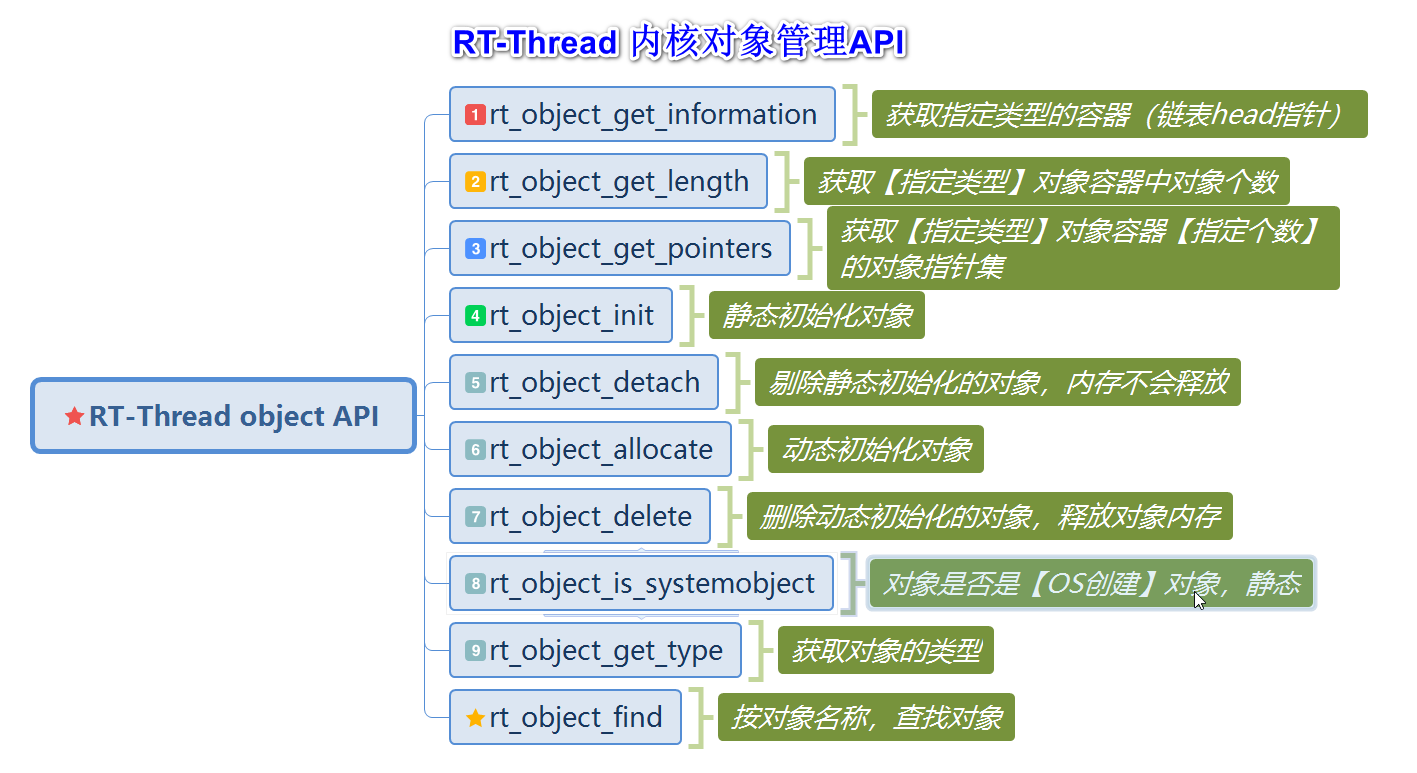溫馨提示×
您好,登錄后才能下訂單哦!
點擊 登錄注冊 即表示同意《億速云用戶服務條款》
您好,登錄后才能下訂單哦!
這期內容當中小編將會給大家帶來有關RT-Thread中的內核對象操作API怎么理解,文章內容豐富且以專業的角度為大家分析和敘述,閱讀完這篇文章希望大家可以有所收獲。
目的還是學習并熟悉RT-Thread 操作系統。
從最簡單的對象管理切入
了解操作系統最基本的組成單位:Object
內核對象的主要操作方法:內核文件:object.c中實現

查看內核文件:object.c,發現的主要的幾個知識點
光看內核代碼,不如敲一敲(抄一下)。
可以使用模擬器,寫幾個測試函數,看看對象操作的流程。
測試用例如下:
/* RT-Thread 內核對象學習 */
#include <rtthread.h>
struct _obj_type
{
enum rt_object_class_type type;
const char* name;
};
/* 靜態的對象定義 */
static struct rt_object _obj[] = { 0 };
/* 測試用,線程對象 */
static const struct _obj_type _obj_tbl[] =
{
{ RT_Object_Class_Thread, "th_01" },
{ RT_Object_Class_Thread, "th_02" },
{ RT_Object_Class_Thread, "th_03" },
{ RT_Object_Class_Thread, "th_04" },
{ RT_Object_Class_Thread, "th_05" },
};
#define OBJ_TEST_TBL_SIZE (sizeof(_obj_tbl) / sizeof(_obj_tbl[0]))
/* 靜態初始化對象 */
void obj_test_init(void)
{
rt_uint8_t index = 0;
rt_uint8_t obj_size = 0;
for (index = 0; index < OBJ_TEST_TBL_SIZE; index++)
{
rt_object_init(&_obj[index], _obj_tbl[index].type, _obj_tbl[index].name);
}
}
/* 動態創建對象 obj_test_create thread1 */
void obj_test_create(uint8_t argc, char** argv)
{
struct rt_object* obj = RT_NULL;
if (argc >= 2)
{
rt_kprintf(" obj_name=%s\n", argv[1]);
}
obj = rt_object_find(argv[1], RT_Object_Class_Thread);
if (obj != RT_NULL)
{
rt_kprintf("obj_name=%s, exist!!\n", obj->name);
return;
}
else
{
rt_object_allocate(RT_Object_Class_Thread, argv[1]);
rt_kprintf("create obj_name=%s\n", argv[1]);
}
}
/* 對象的打印 */
void obj_test_dump(void)
{
rt_uint8_t index = 0;
rt_uint8_t obj_size = 0;
struct rt_object* obj_pointers[OBJ_TEST_TBL_SIZE + 10] = { 0 };
obj_size = rt_object_get_pointers(RT_Object_Class_Thread, obj_pointers, sizeof(obj_pointers));
rt_kprintf("object init : object size=%d\n", obj_size);
rt_kprintf("| index | name | flag | type |\n");
rt_kprintf("+-------+--------------+--------+--------+\n");
for (index = 0; index < obj_size; index++)
{
if (obj_pointers[index] == RT_NULL)
{
break;
}
rt_kprintf("| %03d | %10s | %02d | 0x%02x |\n", index,
obj_pointers[index]->name, obj_pointers[index]->flag,
obj_pointers[index]->type);
}
rt_kprintf("+-------+--------------+--------+--------+\n");
}
/* 查找線程對象 */
void obj_test_find(uint8_t argc, char** argv)
{
struct rt_object* obj = RT_NULL;
if (argc >= 2)
{
rt_kprintf(" obj_name=%s\n", argv[1]);
}
obj = rt_object_find(argv[1], RT_Object_Class_Thread);
if (obj != RT_NULL)
{
rt_kprintf("find obj_name=%s\n", obj->name);
}
else
{
rt_kprintf("not find obj_name=%s\n", argv[1]);
}
}
/* 靜態對象 detach */
void obj_test_detach(uint8_t argc, char** argv)
{
struct rt_object* obj = RT_NULL;
if (argc >= 2)
{
rt_kprintf(" obj_name=%s\n", argv[1]);
}
obj = rt_object_find(argv[1], RT_Object_Class_Thread);
if (obj != RT_NULL)
{
rt_kprintf("find obj_name=%s\n", obj->name);
rt_object_detach(obj);
rt_kprintf("detach obj_name=%s\n", obj->name);
}
else
{
rt_kprintf("not find obj_name=%s\n", argv[1]);
}
}
/* 動態對象 delete */
void obj_test_delete(uint8_t argc, char** argv)
{
struct rt_object* obj = RT_NULL;
if (argc >= 2)
{
rt_kprintf(" obj_name=%s\n", argv[1]);
}
obj = rt_object_find(argv[1], RT_Object_Class_Thread);
if (obj != RT_NULL)
{
rt_kprintf("find obj_name=%s\n", obj->name);
rt_object_delete(obj);
rt_kprintf("delete obj_name=%s\n", obj->name);
}
else
{
rt_kprintf("not find obj_name=%s\n", argv[1]);
}
}
/* 導出命令 */
MSH_CMD_EXPORT(obj_test_init, object init test);
MSH_CMD_EXPORT(obj_test_create, obj create test);
MSH_CMD_EXPORT(obj_test_dump, object test dump);
MSH_CMD_EXPORT(obj_test_find, object test find);
MSH_CMD_EXPORT(obj_test_detach, object test detach);
MSH_CMD_EXPORT(obj_test_delete, object test del);發現:tshell 是動態創建的線程
發現:tidle 是靜態的線程
msh />obj_test_dump object init : object size=2 | index | name | flag | type | +-------+--------------+--------+--------+ | 000 | tshell | 00 | 0x01 | | 001 | tidle0 | 00 | 0x81 | +-------+--------------+--------+--------+ msh />
動態對象,創建后,內存占用增加。
動態對象,刪除后,內存占用恢復
msh />free total memory: 8388580 used memory : 5164 /* 【5164】 內存原有大小 */ maximum allocated memory: 7336 msh /> msh />obj obj_test_init obj_test_create obj_test_dump obj_test_find obj_test_detach obj_test_delete msh />obj_test_cre obj_test_create msh />obj_test_create hello obj_name=hello create obj_name=hello msh /> msh />fre free msh />free total memory: 8388580 used memory : 5304 /* 【5304】 內存占用 */ maximum allocated memory: 7336 msh /> msh />obj_test_delete hello obj_name=hello find obj_name=hello delete obj_name=hello msh />free total memory: 8388580 used memory : 5164 /* 【5304】,內存占用恢復 */ maximum allocated memory: 7336 msh />
靜態初始化的對象,detach(剔除對象管理)后,內存占用不變。
msh />obj_test_init msh />ob obj_test_init obj_test_create obj_test_dump obj_test_find obj_test_detach obj_test_delete msh />obj_test_du obj_test_dump msh />obj_test_dump object init : object size=7 | index | name | flag | type | +-------+--------------+--------+--------+ | 000 | th_05 | 00 | 0x81 | | 001 | th_04 | 00 | 0x81 | | 002 | th_03 | 00 | 0x81 | | 003 | th_02 | 00 | 0x81 | | 004 | th_01 | 00 | 0x81 | | 005 | tshell | 00 | 0x01 | | 006 | tidle0 | 00 | 0x81 | +-------+--------------+--------+--------+ msh />free total memory: 8388580 used memory : 5164 maximum allocated memory: 7336 msh /> msh />obj obj_test_init obj_test_create obj_test_dump obj_test_find obj_test_detach obj_test_delete msh />obj_test_deta obj_test_detach msh />obj_test_detach th_04 obj_name=th_04 find obj_name=th_04 detach obj_name=th_04 msh />obj_test_du obj_test_dump msh />obj_test_dump object init : object size=6 | index | name | flag | type | +-------+--------------+--------+--------+ | 000 | th_05 | 00 | 0x81 | | 001 | th_03 | 00 | 0x81 | | 002 | th_02 | 00 | 0x81 | | 003 | th_01 | 00 | 0x81 | | 004 | tshell | 00 | 0x01 | | 005 | tidle0 | 00 | 0x81 | +-------+--------------+--------+--------+ msh /> msh />free total memory: 8388580 used memory : 5164 maximum allocated memory: 7336
上述就是小編為大家分享的RT-Thread中的內核對象操作API怎么理解了,如果剛好有類似的疑惑,不妨參照上述分析進行理解。如果想知道更多相關知識,歡迎關注億速云行業資訊頻道。
免責聲明:本站發布的內容(圖片、視頻和文字)以原創、轉載和分享為主,文章觀點不代表本網站立場,如果涉及侵權請聯系站長郵箱:is@yisu.com進行舉報,并提供相關證據,一經查實,將立刻刪除涉嫌侵權內容。